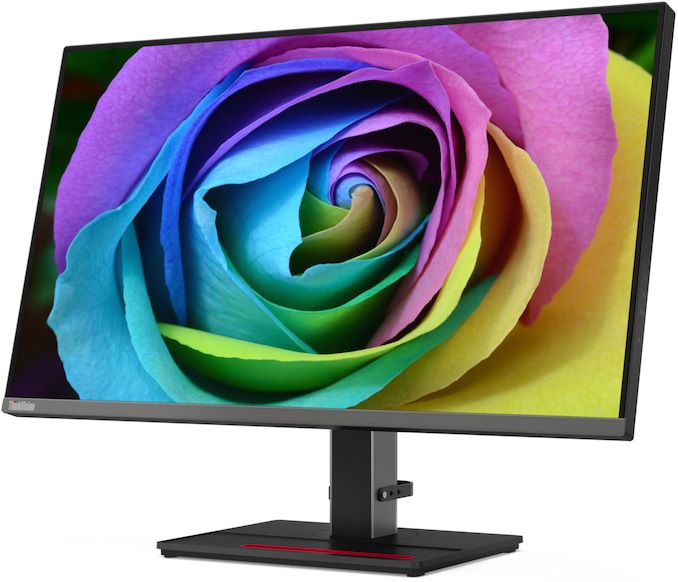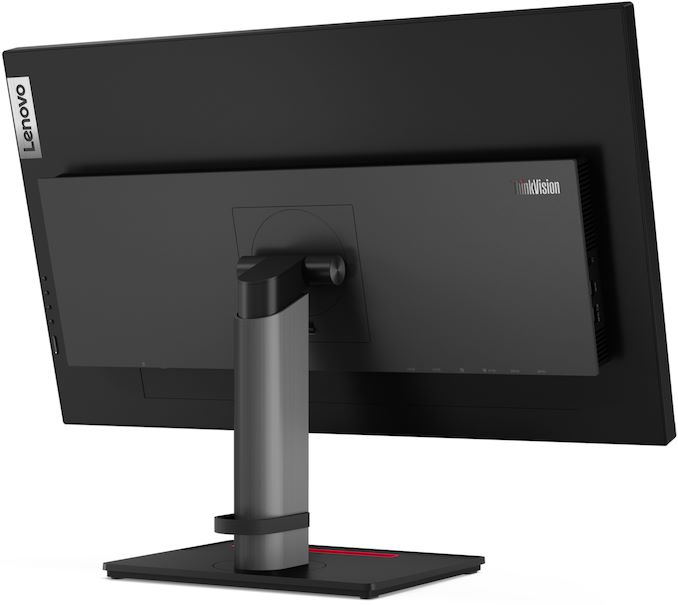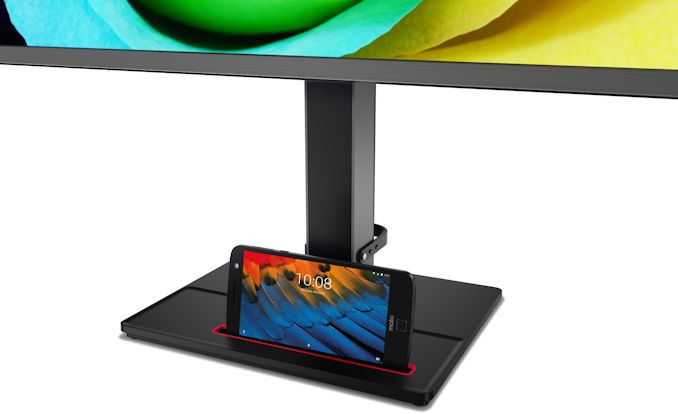Lenovo Unveils ThinkVision Creator Extreme P27: A Professional Monitor with Mini LED FALD
by Anton Shilov on January 3, 2020 2:00 PM EST- Posted in
- Monitors
- Displays
- Lenovo
- IPS
- Trade Shows
- 4K
- ThinkVision
- Mini LED
- CES 2020

Continuing our run of CES 2020 announcements, Lenovo has announced its new ThinkVision Creator Extreme top-of-the-range professional-grade display. The new 27-inch Ultra-HD monitor features a Mini LED-based full-area local dimming (FALD) backlighting that enables a very high brightness in HDR mode along with matching contrast ratios.
As its name suggests, the Lenovo ThinkVision Creator Extreme P27 is designed for various content creators who need a 3840x2160 resolution display with accurate colors (100% of the sRGB and 99% of the DCI-P3 color gamut). The high-end monitor also offers HDR support, with a peak brightness of 1000 nits. The P27 comes factory calibrated and can be used for color-critical workloads by designers or videographers right out of the box.
The key feature of Lenovo’s ThinkVision Creator Extreme P27 is its Mini LED FALD backlighting, which offers 1152 zones (and 10,368 LEDs), three times as many zones as the first generation of FALD PC monitors. This allows the P27 to enable higher contrast ratios, deep blacks (when compared to LCDs with regular WLED backlighting), and the necessary total brightness required for HDR. Lenovo is not disclosing an official contrast ratio specification, though it is safe to say that we are talking about something considerably higher than that of typical IPS displays. The company also does not say which HDR transport formats are supported by the monitor, which is a little bit odd given its positioning.
To meet requirements of users with different computers, Lenovo equipped its ThinkVision Creator Extreme P27 with four display inputs: one DisplayPort 1.4, two HDMI 2.0, and one USB Type-C port with DP 1.4 Alt mode support and 90 W Power Delivery. One interesting feature of the new professional display from Lenovo is a special holder for a smartphone which lets users to follow lock screen announcements and save some space on the desk.
Lenovo’s ThinkVision Creator Extreme P27 will be available this April for $2,499. Considering the fact that to date only Acer and ASUS have introduced Mini LED-enabled professional-grade monitors, the very high price tag of Lenovo’s monitor does not come as a surprise.
| ThinkVision Creator Extreme P27 Specifications | ||
| Panel | 27" IPS | |
| Resolution | 3840 × 2160 | |
| Refresh Rate | 60 Hz | |
| Response Time | 14 ms gray-to-gray | |
| Brightness | Normal: ? cd/m² HDR mode: 1000 cd/m² |
|
| Contrast | ? | |
| Viewing Angles | 178°/178° horizontal/vertical | |
| Color Saturation | 100% sRGB 99% DCI-P3 |
|
| Display Colors | 1.07 billion | |
| 3D-LUT | ? bits | |
| Pixel Pitch | 0.1557 mm² | |
| Pixel Density | 163 PPI | |
| Anti-Glare Coating | ? | |
| Inputs | 1 × DP 1.4 2 × HDMI 2.0b 1 × USB Type-C |
|
| USB Hub | 4-port USB 3.0 hub | |
| Audio | none 3.5-mm mini jack |
|
| Mechanical Design | Chassis Colors: black, metallic. Tilt: yes Height Adjustment: yes Swivel: yes |
|
| Power Consumption | Idle | ? |
| Active | ? | |
| Price | $2,499 | |
Related Reading:
- ASUS ProArt PA32UCG: The Ultimate Mini LED 4K 120 Hz Monitor with HDR 1600
- ASUS Mini LED Professional Monitors Update: Available This Year
- Acer Joins Mini LED Monitor Club with Professional-Focused ConceptD CM7321K
- ASUS at CES 2019: ProArt PA32UCX 4K Monitor with 1000-Zone FALD Unveiled
- AUO’s Mini LED Monitors: 32-Inch 4Kp144, 65-Inch 4Kp144, VR, & Others
- Lenovo Announces ThinkVision P32u LCD: 32-inch, 4K, TB3 with Daisy Chaining
Source: Lenovo













20 Comments
View All Comments
willis936 - Friday, January 3, 2020 - link
Wow. This makes the new apple monitor a lot less attractive. That’s quite the price for what it is.Valantar - Friday, January 3, 2020 - link
Well, the Apple monitor has 2.25x more pixels and can sustain 1000 nits rather than peak at that value, but I see your point. 4k is still a very good resolution, 1000 nits peak is still good, and that contrast ratio and 99% P3 are nothing to scoff at at all. All for the price of a couple of Apple monitor stands with a couple of VESA adapters thrown in. This definitely ought to tempt some people away from the Apple display, that's for sure.lilkwarrior - Sunday, January 5, 2020 - link
It absolutely doesn’t without its HDR information. It’s DOA to its core audience if it doesn’t have Dolby Vision HDR, HLG, & HDR10ltcommanderdata - Friday, January 3, 2020 - link
They're really not in the same class. This Lenovo monitor can do 1000 nits peak brightness and supports 2 colour profiles. The Apple Pro Display XDR does 1000 nits sustained full screen, 1600 nits peak, and offers a wide variety of calibrated reference modes. Apple was very clear in their positioning for the XDR, it's competing against $10,000+ studio reference monitors, which is a very niche market. If you're not working on high-end, high-budget video projects, as you say, other monitors like this Lenovo would offer better value.lilkwarrior - Sunday, January 5, 2020 - link
This monitor also got to compete with stiff competition; the PA32UCG & PA32UCX for startersksec - Saturday, January 4, 2020 - link
Apple ProXDR is a much better product over all, So Lenovo would have to bump up the spec it would have likely cost close to 4K. The current ASUS ProArt cost ~$4000 for a slightly worst than XDR, while it will have an updated version that out spec Apple they haven't announce it's price yet. XDR also wins on Design and IO.So yes it still has some Apple Tax, but in terms of percentage it is by far the lowest across all product lines.
willis936 - Saturday, January 4, 2020 - link
Is it a much better product? It has half as many FALD zones and is twice the price.sonny73n - Sunday, January 5, 2020 - link
To sheeple, it is.TEAMSWITCHER - Sunday, January 5, 2020 - link
Why does the PC Monitor Industry refuse to offer resolutions beyond 4K? Apple has had a 5k iMac for years now, and this 6K Pro Display HDR is a whopping 6K. Even the TV industry is moving into 8K. If I wanted a display for HDR content I would probably just buy an LG C9 OLED over anything the PC Monitor industry is selling... It's cheaper than this.lilkwarrior - Sunday, January 5, 2020 - link
Because Apple does a great job offering resolutions that enables creatives pros great UX to edit 4K+ content. 5K was to have extra room vertical room to edit 4K material.6K is for horizontal & vertical space editing 4K content.
8K monitors & TVs are DOA without HDMI 2.1 & DisplayPort 2.0 for 8K at higher than 30hz. Apple & LG does a good job understanding this.